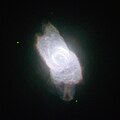Файл:NGC 6572.jpg
Выгляд
NGC_6572.jpg (500 × 500 кропак, аб’ём файла: 135 KB, тып MIME: image/jpeg)
Гісторыя файла
Націснуць на даце з часам, каб паказаць файл, якім ён тады быў.
| Дата і час | Драбніца | Памеры | Удзельнік | Тлумачэнне | |
|---|---|---|---|---|---|
| актуальн. | 20:08, 14 снежня 2010 |  | 500 × 500 (135 KB) | Antonsusi | Better jpg-quality, less environment of no interest |
| 17:59, 13 снежня 2010 |  | 629 × 638 (68 KB) | Jmencisom | {{Information |Description={{en|1=The NASA/ESA Hubble Space Telescope has turned its eagle eye to the planetary nebula NGC 6572, a very bright example of these strange but beautiful objects. Planetary nebulae are created during the late stages of the evol |
Выкарыстанне файла
Наступная 1 старонка выкарыстоўвае гэты файл:
Глабальнае выкарыстанне файла
Гэты файл выкарыстоўваецца ў наступных вікі:
- Выкарыстанне ў ar.wikipedia.org
- Выкарыстанне ў az.wikipedia.org
- Выкарыстанне ў ce.wikipedia.org
- Выкарыстанне ў cs.wikipedia.org
- Выкарыстанне ў de.wikipedia.org
- Выкарыстанне ў diq.wikipedia.org
- Выкарыстанне ў en.wikipedia.org
- Выкарыстанне ў fa.wikipedia.org
- Выкарыстанне ў fr.wikipedia.org
- Выкарыстанне ў hr.wikipedia.org
- Выкарыстанне ў it.wikipedia.org
- Выкарыстанне ў it.wikibooks.org
- Выкарыстанне ў kk.wikipedia.org
- Выкарыстанне ў mk.wikipedia.org
- Выкарыстанне ў nl.wikipedia.org
- Выкарыстанне ў pl.wikipedia.org
- Выкарыстанне ў pt.wikipedia.org
- Выкарыстанне ў ru.wikipedia.org
- Выкарыстанне ў sk.wikipedia.org
- Выкарыстанне ў tr.wikipedia.org
- Выкарыстанне ў tt.wikipedia.org
- Выкарыстанне ў www.wikidata.org
- Выкарыстанне ў zh.wikipedia.org


